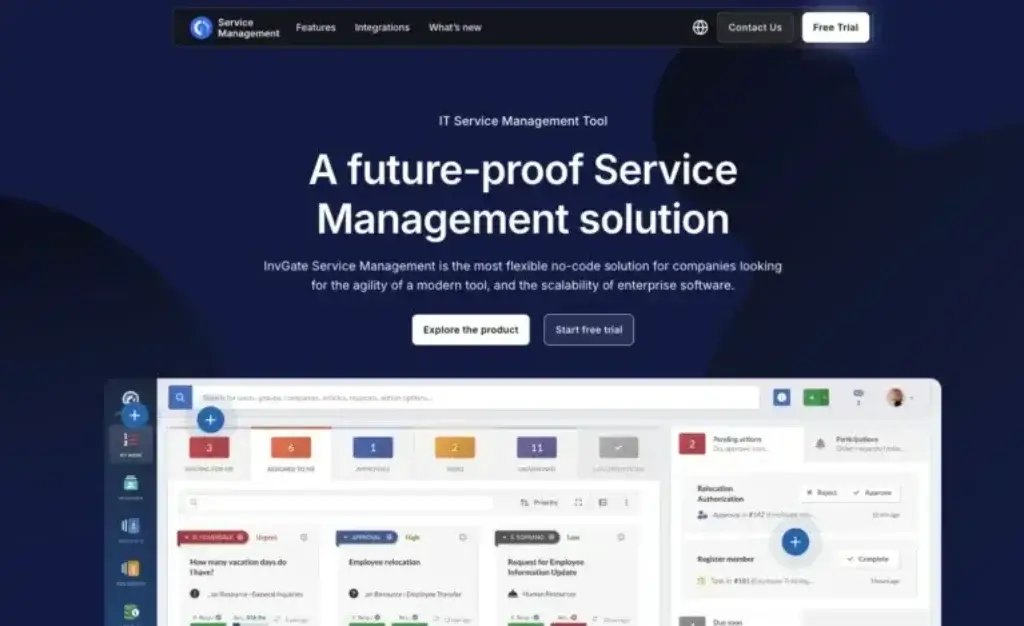Introduction
Selecting the right IT Service Management (ITSM) solution can dramatically impact your team’s productivity, customer satisfaction, and operational resilience. In an era where seamless digital experiences are expected, your IT department needs tools that simplify ticketing, automate repetitive tasks, and provide clear visibility across the service lifecycle. Invgate Service Management promises exactly that. It’s marketed as a modern service management platform with built‑in intelligence that blends no‑code design with AI‑assisted workflows, aiming to help teams resolve issues faster and scale effortlessly. This review looks at its core features, pricing, user experience, pros and cons, and how it compares with leading alternatives such as Monday.com, Freshservice, and ServiceNow.
If you’re exploring the broader ITSM landscape, check out our comparison of the best ITSM software. For smaller teams, we’ve also rounded up the best ITSM software for small businesses to help you find a solution tailored to your needs.
Software Specification
Core Features of InvGate
Invgate’s feature set is designed to cover everything from incident tracking to proactive problem management. The platform emphasizes no‑code configuration and embedded AI to simplify complex processes. Here’s a closer look at its key modules.
Ticket Management
The core of any ITSM platform is its ticketing system, and Invgate elevates this with AI‑powered capabilities. The platform automatically categorises and routes incoming tickets based on historical patterns, urgency, and context. Agents receive suggested responses and knowledge articles in real time, reducing manual triage and enabling faster resolutions. Tickets can be captured across multiple channels, including email, self‑service portal, chat, and AP, and Invgate’s built‑in collaboration tools provide centralised comments, custom views, and full audit trails to ensure transparency. An AI‑powered virtual service agent deflects common requests directly in Microsoft Teams, WhatsApp, or the self‑service portal.
Benefits of Ticket Management
- Increased speed of service restoration: AI‑driven categorisation and suggested responses mean agents spend less time routing and more time resolving issues.
- Improved customer satisfaction: Multi‑channel ticket capture and instant visibility into user context allow faster, more personalised support.
- Operational transparency: Centralised audit trails and activity logs offer clear accountability.
- Higher productivity: Built‑in automation, approvals, and reminders help agents stay organised and avoid SLA breaches.
Self‑Service Portal
Invgate’s self‑service portal lets employees and customers resolve issues without waiting for an agent. The portal is highly customisable; administrators can change colours, logos and layouts to match company branding. A responsive design ensures mobile access on any device, while integration with popular authentication services like Microsoft 365, G Suite and Azure enables single sign‑on and easy user import. Users can submit and track incidents, request approvals, and browse a unified service catalog. Integrated knowledge base articles surface relevant solutions via the portal’s search function, and notifications keep users updated on incident status changes. Feedback forms and surveys capture customer satisfaction metrics, while configurable dashboards and reports provide management with real‑time insights. Multi‑language and regional settings allow global organizations to personalise time zones, currencies, and language preferences.
Workflow Automation
One of Invgate’s standout features is its visual, no‑code workflow builder. This drag‑and‑drop tool allows you to create workflows that reflect complex processes across IT and business departments. The interface makes it easy to insert forms, approvals, and task lists and to build conditionals for different scenarios. You can duplicate frequently used steps, undo or redo changes with a click, and control form field visibility based on user roles. For teams that want a quick start, Invgate includes a library of pre‑built templates covering common processes like employee onboarding, change approvals, knowledge article creation, and software requests. These templates are especially useful for non‑technical teams looking to streamline operations without writing code.
AI‑Powered Virtual Service Agent
To reduce ticket volume and improve self‑service adoption, Invgate offers an AI virtual service agent. The agent plugs into your existing knowledge base and past tickets, meaning no manual training is required. You can deploy it across Microsoft Teams, WhatsApp or the self‑service portal to meet users where they already communicate. Conversations feel human‑like—similar to popular generative AI chatbots—so users can ask questions in natural language. Built‑in safety measures ensure conversations are never used to train third‑party models, keeping sensitive information private. The result is lower ticket volume and higher agent productivity because repetitive questions are deflected before they reach the service desk.
Change Management
Invgate’s change management module helps teams manage risk while embracing change. Using the same workflow builder and automation engine, the system guides each request for change (RFC) from logging and assessment through approval and release. The tool is ITIL‑certified, ensuring processes align with best practices. Because Invgate’s modules sit on a single platform, change management integrates seamlessly with incident, problem, and configuration management. A full reporting suite offers analytics on how well changes are handled, with audit trails to meet governance requirements. Benefits include preventing change‑related incidents, improving major incident management, and satisfying governance needs.
Problem Management
Recurring incidents drain resources, so proactive problem management is essential. Invgate’s PinkVERIFY ITIL‑certified problem management capabilities help teams reduce the impact of known errors. Automation assists with problem identification, root‑cause analysis, workaround creation, and resolution via the change management process. An AI engine detects patterns in incident data and flags potential problems before they become ticket floods. The module links problems with associated incident tickets, enabling global updates and ensuring end users see the latest information. Reporting and analytics give insight into how the process is performing. These capabilities help prevent business‑affecting issues, improve customer satisfaction, and boost staff morale.
Knowledge Base & Analytics
A strong knowledge base underpins Invgate’s self‑service and automation features. Agents can turn resolved tickets into polished, searchable articles using AI‑assisted drafting. The knowledge base aligns with the service catalog, so end users find relevant information quickly. For analytics, Invgate provides custom dashboards that monitor requests, assets and configuration items across 150+ built‑in metrics. Stakeholders can share these dashboards with others to ensure transparency and informed decision‑making. When integrated with InvGate Asset Management, the service desk gains unified visibility into asset‑related incidents, linking configuration items to tickets for proactive troubleshooting. AI‑powered problem detection also feeds insights into analytics, helping teams identify trends and areas for improvement.
Integrations & IT Asset Management
Invgate integrates with a wide range of business tools, including Microsoft Entra ID, Google Workspace, Jira, Slack, SCCM, and more. These integrations allow for automated actions across systems, reducing data silos. The platform also connects seamlessly with InvGate Asset Management to provide a comprehensive view of hardware and software assets. This integration helps service desk agents link configuration items to tickets and makes it easier to track asset lifecycle stages. Additional integrations with Zapier, Okta, SAP, Workday, and other enterprise platforms broaden Invgate’s usefulness for diverse organisations

Pros and Cons
Benefits of Using InvGate
Positive
✅ Comprehensive Feature Set
✅ Powerful Automation Capabilities
✅ Strong Integration Capabilities
✅ Highly Scalable
Negatives
❌ Complexity for Small Businesses
❌ Initial Learning Curve
❌ Higher Initial Investment
❌ Customer Support Response Time
✅ Pros
Invgate offers several advantages that make it stand out among ITSM solutions:
- Comprehensive Feature Set:
It provides robust incident, problem, change, and asset management, plus a no‑code workflow designer and integrated analytics. - AI‑Driven Automation:
Invgate’s AI automatically categorizes tickets, suggests responses, predicts recurring issues, and powers a virtual agent to deflect common requests. - Seamless Integrations: The platform integrates with popular business tools (Microsoft Teams, Slack, Jira, Salesforce, etc.), reducing silos and ensuring data consistency.
- Scalability and Flexibility: Invgate supports both cloud and on‑premise deployments and offers advanced automation for small teams up to large enterprises.
- No‑Code Customisation: Workflows, self‑service portals, and dashboards can be adapted without coding knowledge.
- Comprehensive Analytics: Custom dashboards and 150+ metrics provide actionable insights for service improvement.
❌ Cons
- Complexity for Small Teams:
With its extensive feature set, Invgate may feel heavy for very small teams or those with simple requirements. Smaller organizations might prefer a lighter tool or consult our guide on the best ITSM software for small businesses. - Learning Curve:
While the interface is intuitive, fully leveraging advanced features like conditional workflows and AI configuration can require dedicated training. - Specialised Customisation:
Organisations with highly unique processes may find that no‑code capabilities aren’t sufficient and may need to invest in tailored solutions. - Advanced Reporting Needs: Some users might need supplemental tools to generate deeply customised reports.
User Experience
User Interface and Operational Simplicity
Interface Design and Ease of Use
InvGate focuses on delivering an intuitive user experience. The ticketing dashboard provides immediate visibility into incidents, assets, and related information, reducing navigation clicks. The self‑service portal is fully customizable, and the workflow builder uses a card‑style interface that non‑technical users can understand. Centralised operations and transparent execution through audit trails and collaboration features make it easy for agents to stay organised.
Mobile Accessibility
In a distributed work environment, technicians often need to resolve issues on the go. InvGate’s responsive self‑service portal ensures that users can access support from any device. Although the official website does not provide details about dedicated mobile apps, the platform offers a mobile‑friendly interface and can be accessed through standard mobile browsers. Global time zones and language settings further tailor the experience to regional needs.
Customer Support and Community
InvGate provides multiple support channels, including a knowledge base, webinars, and personalised training sessions. The vendor also offers onboarding assistance and dedicated customer success managers starting from the Pro tier. A growing online community and blog give users additional tips and best practices for maximizing their investment.
Pricing and Plans
How much does InvGate cost?
Overview of Pricing Tiers
According to third‑party sources, InvGate Service Management offers three primary subscription tiers:
- Starter ($17/agent/month, billed annually): Suitable for up to five agents. Includes unlimited end users and approvers, ticket management, knowledge base, self‑service portal, reports and analytics, SLAs, multi‑department support, approval management, automation, and gamification.
- Pro ($40/agent/month, billed annually): Supports 6–50 agents. Adds workflow designer, custom domain with SSL, enterprise service management (ESM) templates, API access, customer success manager, and onboarding/training.
- Enterprise (quote‑based): Designed for unlimited agents. Includes cloud or on‑premise deployment, concurrent seats, multiple SAML support, extended network restrictions, VPN connection, and custom SMTP server.
Tip: Always confirm current pricing directly on the official InvGate pricing page as costs may change. Pricing can also vary based on deployment model (SaaS vs. on‑premise) and additional modules.
Factors Influencing Cost
Pricing depends on several factors:
- Agent Count: InvGate charges per agent, so costs scale with team size.
- Selected Modules: Add‑ons such as InvGate Asset Management or premium workflow automation may increase the subscription fee.
- Deployment Method: On‑premise deployments often carry higher up‑front costs but may reduce long‑term subscription fees, while SaaS offers predictable monthly or annual billing.
- Customisation and Integrations: Specialised integrations or extensive customisation could require professional services or higher‑tier plans.
Comparison with Industry Standards
InvGate’s pricing is competitive compared to enterprise‑grade ITSM solutions like ServiceNow, which typically command higher license fees and require extensive implementation services. It sits between affordable, easy‑to‑use tools like Freshservice and high‑end solutions like ServiceNow. For mid‑sized businesses seeking advanced functionality without enterprise‑level costs, InvGate represents a balanced choice.
Invgate vs. Alternatives
How It Compares to Competitors
Exploring alternative ITSM tools helps ensure you find the best fit for your organization. Below is a comparison of Invgate with three notable competitors: Monday.com, Freshservice, and ServiceNow.
Monday.com: Recommended Top Pick
monday service, by monday.com, stands out as an excellent ITSM solution because it combines intuitive workflow visualisation with strong project management features. It offers user‑friendly dashboards, robust automation, and extensive integrations. For organizations already using Monday.com for project management or CRM, adding the ITSM suite creates a unified platform. Monday.com consistently earns praise for ease of use, rapid deployment, and transparent pricing. It’s a particularly strong fit for small to mid‑sized businesses that need a tool to scale with them while delivering rich data visualisation and collaborative capabilities.
Freshservice
Freshservice, part of the Freshworks suite, is another popular ITSM platform. It emphasises ease of adoption and AI‑powered efficiency. The platform auto‑routes incidents, provides AI assistance, and generates incident reports quickly. Change management is streamlined with visual progress tracking and compliance tools, while problem management incorporates AI insights and timeline‑based root‑cause analysis. Freshservice also supports omnichannel support—agents can manage conversations across email, portals, Slack, and Microsoft Teams from a single view. Its unified service catalog simplifies request fulfillment, and the AI‑driven knowledge base reduces agent workload by guiding users to self‑service solutions. Pricing for Freshservice is often lower than Invgate for small teams, but can rise quickly as you add advanced features.
ServiceNow
ServiceNow is the enterprise benchmark for ITSM. It provides highly customizable modules for incident, problem, change, and request management on a single data model. AI and machine learning enable predictive incident prioritisation and automated remediation suggestions. ServiceNow excels in scalability, integration with IT Operations Management (ITOM,) and extensive workflow orchestration. However, its comprehensive nature means higher license fees and longer implementation timelines. Organizations with complex, enterprise‑wide requirements may prefer ServiceNow, while those seeking faster time‑to‑value might lean toward Invgate or Monday.com.
ManageEngine (Optional Alternative)
ManageEngine’s ServiceDesk Plus offers a more budget‑friendly ITSM tool aimed at small to mid‑sized businesses. It includes incident, problem, change, and asset management, with additional project management capabilities. ManageEngine features a self‑service portal and basic automation, though its interface can feel dated compared to Invgate’s modern design. Pricing is generally lower, but the range of integrations and AI capabilities is more limited.
Quick Comparison Table
Below is a summary of how these tools compare on key criteria. Remember that pricing can vary based on the number of agents and selected modules.
| Solution | Best Suited For | Key Strengths | Pricing Level |
| Invgate | Mid‑sized to large organisations | AI‑powered ticketing, no‑code workflows, integrated asset management | Medium |
| monday.com | Small to mid‑sized businesses | Highly intuitive UI, unified platform for project & service management, rapid deployment | Low‑Medium |
| Freshservice | SMBs & departments | Easy adoption, omnichannel support, AI‑assisted incident & change management | Low‑Medium |
| ServiceNow | Large enterprises | Extensive customization, deep ITOM integration, advanced AI/ML | High |
Conclusion
Final thoughts
InvGate Service Management is a robust ITSM solution offering a comprehensive suite of features, including AI‑driven ticketing, no‑code workflow automation, modern self‑service, and seamless integrations. It is designed to help mid‑sized and large organisations streamline their IT operations, prevent recurring incidents, and improve service quality. The platform shines through its AI capabilities, no‑code configuration, and thorough reporting tools. However, smaller teams or those seeking simpler solutions may find it heavy and should explore alternatives such as Monday.com or Freshservice. Pricing sits in the mid‑range, offering good value for the features provided. Ultimately, choosing an ITSM tool is about aligning features and cost with your organisation’s needs.
Have more questions?







